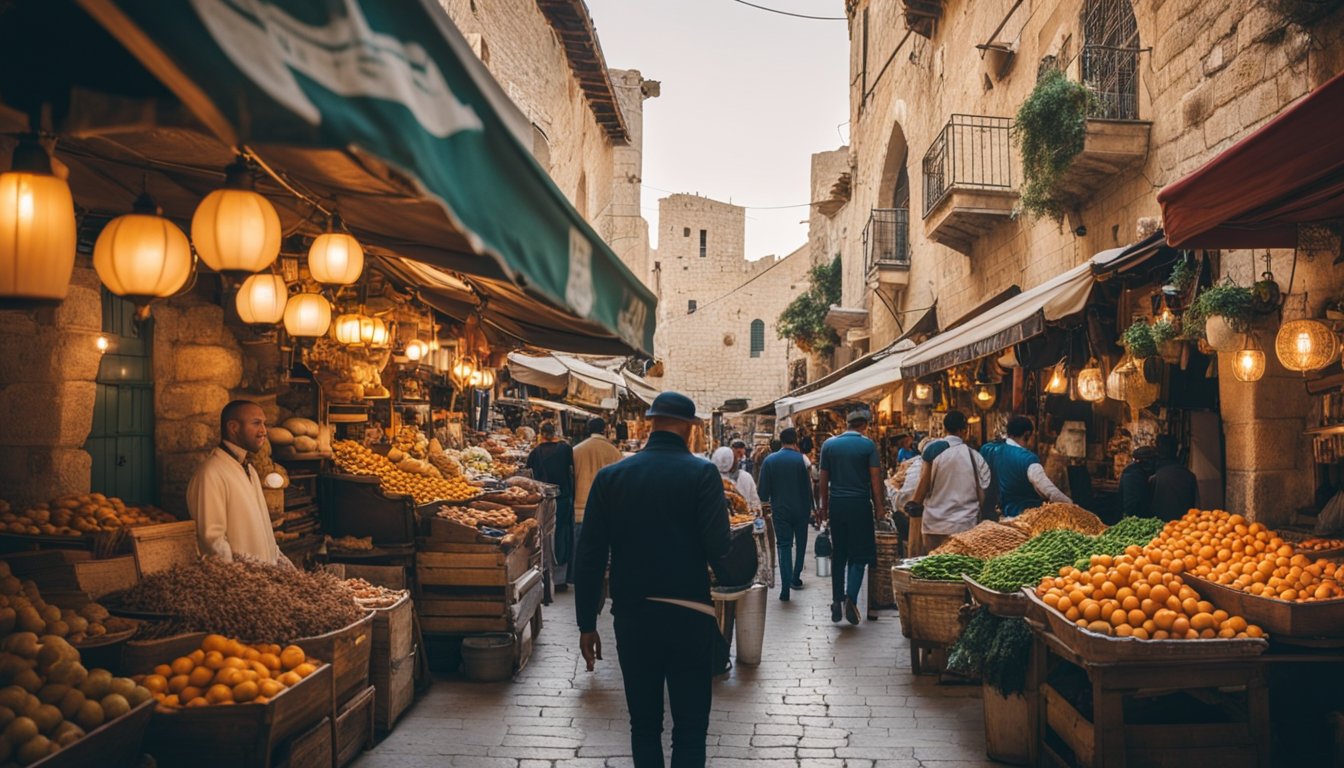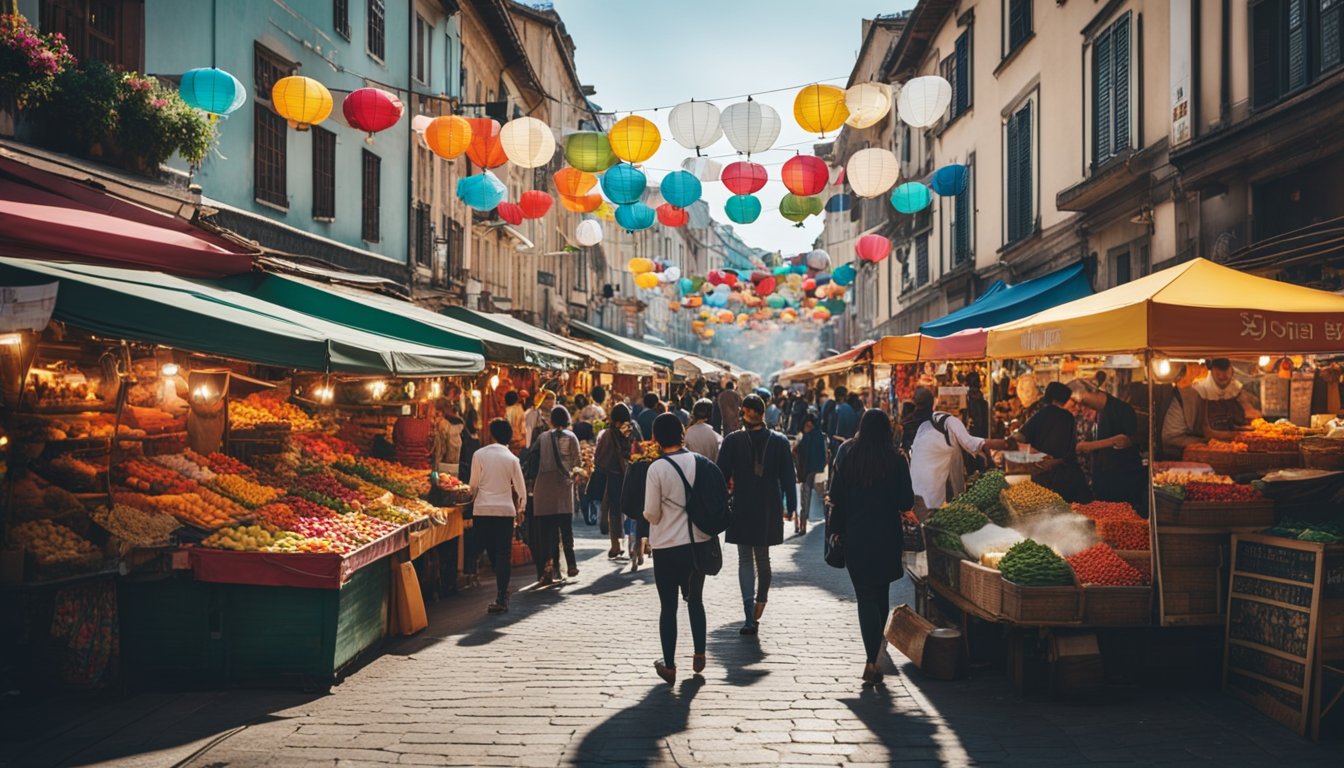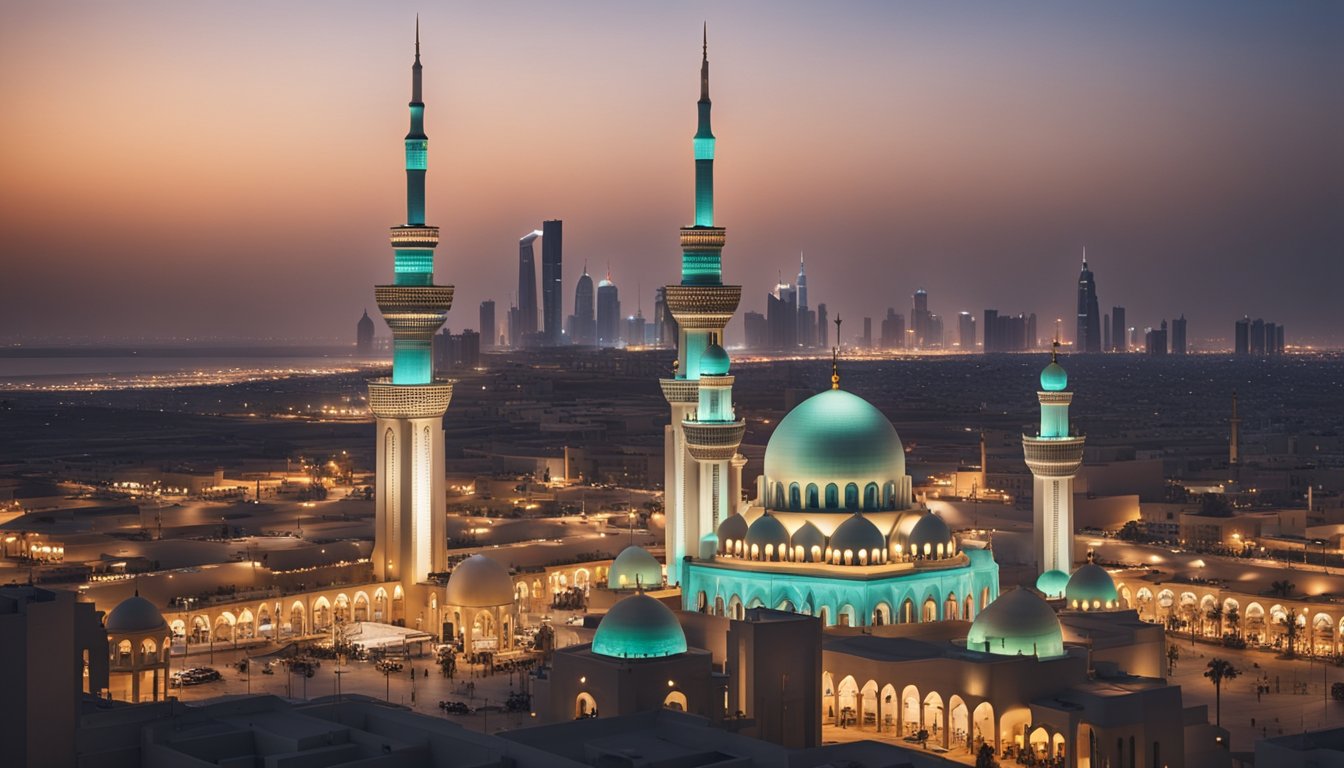Jerusalem’s Old City stands as a crossroads of history, echoing the footsteps of countless pilgrims, traders, and conquerors who have traversed its cobbled streets over millennia. It is the pulsing heart of a city revered as holy by Jews, Christians, and Muslims alike, each laying claim to its ancient stones. The city’s very walls seem to whisper tales of sacred events and earthly struggles, as they enclose significant religious sites such as the Western Wall, the Church of the Holy Sepulchre, and the Dome of the Rock. Its historical significance is not merely a factor of religious importance but also of the enduring human endeavor to connect with something greater than oneself.

The Old City of Jerusalem is a mosaic of cultures, each tile painted with the hues of different civilizations that have risen, fallen, and left their indelible marks on its character. The narrow alleys and grand architecture tell a story of a cultural heritage shaped by diverse influences, from the ancient Israelites to the Babylonians, Romans, Byzantines, Persians, Ottomans, and many others. A guide for travelers venturing into these age-old quarters offers not just a window into the past, but an immersive journey through a living museum where everyday life is superimposed on a tapestry of historical context.
As a traveler explores the Old City, the layers of Jerusalem’s history, with its complexities and confluences, unfold before them. Beyond being a holiest city for many, it is also a symbol of coexistence amid contestation. The Old City’s preservation continues to be a testament to humanity’s deep connection to its own history and traditions. For any traveler passionate about understanding the past’s imprint on the present, a visit to Jerusalem’s Old City is an essential pilgrimage in the quest for knowledge and appreciation of our shared cultural heritage.
History and Foundations

Jerusalem’s Old City is a mosaic of history, encapsulating millennia from the times of ancient civilizations to the modern-day intersections of cultures and conflicts. This section traverses the chronicles of its foundations, the empires that have ruled, and the persistent struggle for coexistence within its walls.
Ancient Roots and Religious Heritage
The City of David marks the beginning of Jerusalem’s storied past, with archaeological evidence suggesting settlement as far back as the 4th millennium BCE. It was here that King David established his capital. His son, Solomon, built the First Temple, further anchoring the city’s spiritual significance to Judaism. The Second Temple era followed, setting the stage for Jerusalem’s religious heritage that now spans the three monotheistic faiths: Judaism, Christianity, and Islam.
- Judaism: The Western Wall, revered as the last remnant of the Second Temple.
- Christianity: Sites like the Church of the Holy Sepulchre, where Jesus is believed to have been crucified and buried.
- Islam: The Al-Aqsa Mosque and the Dome of the Rock, sacred to Muslims.
Through the Ages: Empires and Occupations
Jerusalem’s history is characterized by its strategic importance and spiritual magnetism, leading to a succession of conquerors. The Babylonians laid siege and destroyed the First Temple in 586 BCE. Centuries later, the Romans overtook the city and eventually razed the Second Temple in 70 CE. Subsequent rulers included the Byzantine Empire, which infused the city with Christian influence, and the Ottoman Empire, under which Jerusalem thrived for nearly 400 years until the early 20th century.
| Empire | Contribution/Impact on Jerusalem |
|---|---|
| Roman | Destruction of Second Temple; architectural footprint |
| Byzantine | Christian monasteries; churches |
| Ottoman | Expansion; relative religious tolerance |
Modern Day: Conflict and Coexistence
Post-World War I, Jerusalem transitioned under British control until the 1948 establishment of the State of Israel. This marked the onset of the Israeli-Palestinian conflict, with both parties asserting claims to the city. The Six-Day War in 1967 resulted in Israeli annexation of the Old City, where Jordan had maintained control since 1948. Presently, the Old City of Jerusalem is a hub of historical and contemporary significance, a center of worship and tourism, and a focal point of ongoing conflict and efforts at peaceful coexistence.
Religious and Cultural Tapestry

Jerusalem’s Old City is a unique mosaic where ancient history and living traditions converge. Its quarters host a rich variety of religious traditions and cultural expressions.
The Four Quarters: A Melting Pot of Traditions
The Old City of Jerusalem is divided into four distinct quarters: Muslim, Christian, Jewish, and Armenian. Each contributes to the city’s cultural fabric.
- Muslim Quarter: Vibrant bazaars and the majestic Dome of the Rock define this quarter. It is also home to Al-Aqsa Mosque and Haram al-Sharif, a site revered in Islam as the destination of Prophet Muhammad’s night journey.
- Christian Quarter: This quarter houses the Church of the Holy Sepulchre, the site identified with Jesus’ crucifixion and resurrection. The Via Dolorosa, or the Way of Sorrow, culminating in this church, is a focal point during Easter commemorations.
- Jewish Quarter: The historical Western Wall Tunnels offer insight into ancient Jewish life. The Western Wall itself is a central place of prayer and spirituality for the Jewish people.
- Armenian Quarter: Though often less highlighted, this quarter has a rich heritage and contributes to the religious tapestry, with ancient churches representing Armenian Christian traditions.
Significant Religious Sites and Practices
Jerusalem’s Old City is dotted with sites sacred to Judaism, Christianity, and Islam, each with unique practices and spiritual significance.
- Judaism: The Western Wall, part of the ancient Jewish Temple’s retaining wall, is a sacred place of worship where prayers ascend day and night.
- Christianity: The Church of the Holy Sepulchre marks the events of Jesus’ crucifixion and resurrection. Pilgrimages and liturgical services, especially around Easter, demonstrate the deep connection to these events.
- Islam: Dome of the Rock and Al-Aqsa Mosque on the Temple Mount, or Haram al-Sharif, are focal points for Muslim prayer and spirituality, reflecting the city’s profound significance in Islamic history.
Architectural Marvels

The Old City of Jerusalem encapsulates a rich tapestry of architectural achievements, from its ancient protective barriers to its centuries-old and modern edifices. This homage to historical craftsmanship showcases structures that have served as silent witnesses to the city’s tumultuous past.
Ancient Walls and Gates
Jerusalem’s Old City walls, erected by Suleiman the Magnificent in the 16th century, extend approximately 4 kilometers, encasing a history of strategic defense and architectural prowess. The walls incorporate eight gates, of which seven are presently open. Notably, the Jaffa Gate serves as a main portal into the Old City, leading to the Christian and Armenian quarters. On the southeastern end, the Dung Gate provides direct access to the Jewish quarter and the Western Wall. The Zion Gate, pockmarked from past conflicts, and the sealed Golden Gate, which holds religious significance for multiple faiths, are also significant for their historical roles and distinct design elements. These fortifications offer panoramic views of the city and embody the timeline of Jerusalem’s storied past.
-
Gates Open to Public:
- Jaffa Gate
- Zion Gate
- Dung Gate
- Herod’s Gate
- Damascus Gate
- The New Gate
- Lions’ Gate
-
Sealed Gate:
- Golden Gate
Noteworthy Structures: Past and Present
Within these walls lies the Tower of David, an ancient citadel located near the Jaffa Gate. Despite its name, the tower dates back to the Mamluk and Ottoman periods, much later than King David’s reign, and now houses a museum holding frequent exhibitions. Its robust structure and displays illustrate the city’s lineage through an architectural lens. Another engineering feat is the Siloam Tunnel, an ancient aqueduct that transported water from the Gihon Spring to the Pool of Siloam. Carved through solid rock around the 8th century BCE, it marks one of the most impressive underpinnings of Jerusalem’s infrastructure.
- Citadel and Museum: Tower of David
- Ancient Waterworks:
- Gihon Spring
- Siloam Tunnel
Cultural Experiences and Daily Life

Jerusalem’s Old City offers an immersive experience into its rich cultural tapestry, through its bustling marketplaces and the enduring legacy of its Armenian community.
Marketplaces and Narrow Streets
The marketplaces in Jerusalem’s Old City, especially along its narrow streets, are a hub of cultural exchanges where the modern life briskly interlaces with historical narratives. Visitors can witness an array of traditional and contemporary goods, ranging from handcrafted artifacts to aromatic spices. Via Dolorosa and Suq Khan El-Zeit stand out as significant market arteries, alive with the calls of vendors and the negotiation of prices. Here, one can sense the living heart of the city, with goods laid out in a dense mosaic of colors and textures, offering a truly vivid shopping experience.
Armenian Community and Heritage
The Armenian presence in Jerusalem dates back centuries and is deeply woven into the city’s fabric. The Armenian Patriarchate of Jerusalem, located in the Armenian Quarter, symbolizes their historical and spiritual significance. This religious establishment serves as the center for Armenian Christians in the Holy Land and works to preserve their cultural heritage. The community also memorializes the Armenian Genocide with commemorations held within the city.
The Armenian Museum offers a unique perspective on the community’s history, showcasing a wide range of artifacts that articulate the Armenian cultural identity. These range from ancient manuscripts to traditional ceramics, encapsulating millennia of history within its walls. The museum and other cultural institutions, such as the educational St. James School, stand as testaments to the resilience and vibrancy of the Armenian heritage in Jerusalem, contributing to the diverse cultural atmosphere that defines the Old City.
Conservation and Impact

Jerusalem’s Old City is a mosaic of histories and cultures, safeguarded through consistent conservation efforts and recognized for its deep-rooted significance in human legacy.
UNESCO and Global Recognition
Jerusalem’s Old City is a designated UNESCO World Heritage Site, a status that underscores its universal value to humanity. In recognition of its spiritual importance and cultural heritage, UNESCO works diligently to preserve the city’s integrity against the pressures of modern development. Ancient history is enshrined in its cobbled alleyways and iconic landmarks, with special emphasis placed on sites such as the Western Wall Plaza and traces of King Solomon‘s reign.
| UNESCO Initiatives for Conservation | Impact |
|---|---|
| Monitoring heritage sites | Sustainable preservation of cultural and historical integrity |
| Educating on the site’s significance | Enhanced global awareness and appreciation for the site’s heritage |
| Coordinating international efforts | Unity in conservation practices and symbolic peace |
Education and the Role of Museums
Museums within the walls of Jerusalem’s Old City, such as the Tower of David Museum and the Armenian Museum, play paramount roles in conveying the region’s layered past. These institutions are custodians of knowledge with exhibits that elucidate ancient history and King Solomon‘s era through artifacts and narratives. They also explore the spiritual importance and cultural heritage of the city, thereby enriching visitors’ understanding and appreciation for its significance.
- Tower of David Museum: Educates on the historical and archaeological significance.
- Armenian Museum: Showcases artifacts of the Armenian community and their longstanding presence.
Tourism and Economic Influence
Tourism is a pivotal economic driver in Jerusalem’s Old City, with tourists flocking particularly during holiday periods to experience its sacred ambiance. The economic influence of tourism is multifaceted:
- Direct support for local businesses and marketplaces.
- Funding for ongoing conservation initiatives.
Visitor engagement with landmarks such as the bustling Western Wall Plaza bolsters the necessity of well-maintained sites, ensuring that both the tangible and intangible heritage endure for future generations. Sustainable tourism also helps cement the city’s role as a living symbol of global historical consciousness.



